여니수니와 함께 떠나는 여수 여행ㆍ9(Trip to Yeosu with Yeoni and Suni⋅9)"여수가 한국의 나폴리라고요?"("Is Yeosu the Napoli of Korea?")"아니에요. 나폴리가 이탈리아의 여수이지요."("No, Napoli is the Yeosu of Italy.")

▲수녀님 인터뷰서교동성당에서 맹 글라라 수녀님과 인터뷰를 하면서, 우리는 여수가 얼마나 아름다운 곳인지 새삼 알게 되었어요. (While interviewing sister Maeng Geulrara in Seogyodong cathedral, we discovered beautiful Yeosu is.)
ⓒ 정종현
'아름다운 물'이라니, 여수(麗水)처럼 아름다운 이름을 가진 곳이 또 있을까요? 고려 태조 때인 940년에 '여수현'이라는 이름을 처음 갖게 되었다는데, 천년 이후에 이곳에서 '아름다운 물의 축제'인 여수 엑스포가 열리게 될 것을 우리 조상님들은 미리 아셨을까요? 머리가 희끗희끗한 맹민영 글라라 수녀님을 만나면서 우리는 이런 생각을 하게 되었어요.
(Is there any place that has as a beautiful name as Yeosu, which means "beautiful water"? Yeosu was originally named Yeosuhyeon during the Goryeo Dynasty (918-1392) in 940, during the reign of Emperor Taejo. Did our ancestors know that Yeosu Expo, the beautiful water festival, would be held here one thousand years later? Thoughts like these came to us during our meeting with the gray-haired sister Maeng Geulrara.)수녀님은 이탈리아에서 5년 동안 공부하시면서 나폴리, 베니스 등 유명한 도시들을 많이 둘러보셨대요. 물론 나폴리도 아름답고 베니스도 아름답대요. 하지만 여수의 아름다움에 비길 바가 아니래요. 오히려 오래된 문화재, 아기자기한 섬들이 보이는 깨끗한 바다와, 해안을 따라 완만한 곡선을 이루며 이어져 있는 길은 나폴리보다 훨씬 아름답다고 하셨어요. 한마디로 멋진 곳이래요, 여수는. 그래서 우리는 '그 섬'으로 떠나기로 했어요.
(She studied in Italy for five years, and toured many famous cities like Napoli and Venice. She told me that both Napoli and Venice are very beautiful. But above all, there is no place more beautiful than Yeosu. She said that Yeosu is more beautiful than Napoli, Because of its cultural landmarks, its clean waters and charming islands, and the sinuous roads that curve alongside the seashore. Yeosu is a wonderful place. So we wanted to visit an island.)"그 섬을 보고 싶어서 오동도에서 유람선을 탔는데……"("Wanting to see the island, we boarded a boat at Odongdo.")
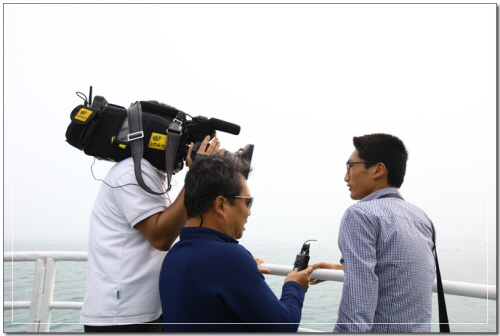
▲우리 동아리 활동 취재 MBC에서 우리 동아리 활동을 취재하던 날, 유람선을 탔어요. 하지만 운무에 가린 ‘그 섬’은 좀처럼 제 모습을 드러내지 않았어요. (On the day MBC was covering our club activities, we boarded a boat to see 'the island', but it was veiled by fog.) ⓒ 지현우
'그 섬'이라고 하니 궁금하시죠? 엑스포가 열리는 오동도에서 바라다보이는 '돌산'이에요. 돌산은 돌산도·송도·금죽도 등 세 개의 유인도와 항대도·서근도 등 열아홉 개의 무인도로 이루어져 있는데요. 그 돌산을 보러 우리는 유람선을 탔어요. 그런데 그날따라 운무가 끼어 돌산은 끝내 그 모습을 드러내지 않았어요. 돌산은 마치 우리더러 땅을 밟고 다시 오라고 하는 것 같았어요.
(Do you wonder why I say 'the island'? The island is Dolsan, which can be seen from Odongdo. Dolsan consists of Dolsando (island), Songdo, and Geumjukdo, which are inhabited, and Seogeundo, Hangdaedo, and seventeen other islands uninhabited. We boarded a boat to take a look at Dolsan. Unfortunately, it was so foggy that Dolsan never appeared on that particular day. It seemed that Dolsan was telling us that we should return to the mainland.)"그래서 돌산대교를 따라 땅을 밟으며 들어갔죠."(So we went there by taking Dolsan Bridge.)

▲돌산대교 들어 가는 길 여수시 남산동과 돌산읍 우두리를 연결하는 돌산대교에요. 폭 11.7m, 길이 450m로 1984년에 완공되었는데, 여전히 아름다워요. (This is Dolsan Bridge which connects Yeosu Namsan-dong with Dolsan Udu-ri. Its width is 11.7m and its length is 450m. It was completed in 1984, but it is still beautiful.) ⓒ 김경훈
돌산대교를 건너는 순간부터 돌산은 자기 몸을 하나씩 보여 주기 시작했어요. 개통한 지 30년이 다 돼 가는데도, 62m 높이의 A자형 교탑은 여전히 미려한 경관을 자랑하고 있고요. 왼편으로는 연인들의 데이트 코스로 알려진 장군도가 보이고, 맞은편으로는 여수를 한눈에 내려다볼 수 있는 돌산공원이 보이고, 오른편으로는 시원한 바닷바람과 함께 쪽빛 바다가 펼쳐졌어요.
(From the moment we crossed Dolsan Bridge, Dolsan started to show itself. Although the bridge has been open for 30 years, the A-type bridge 62m high still vaults over the beautiful scenery. On the left, we can see JangGun island which is known as a dating place for lovers. We can also see Dolsan park, where you can get a panoramic view of Yeosu. On the right, the blue sea unfolds beneath the cool sea breeze.)"바다가 아름다운 건 무엇 때문일까요?"(Why is the sea beautiful?)
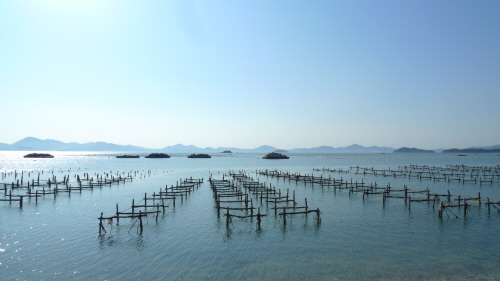
▲굴 양식장 평사마을의 굴 양식장이에요. 바다가 아름다운 것은 그냥 풍경이 아니라 치열한 삶이 있어서가 아닐까요? (It is an oyster farm in Pyeongsa village. Is it not only the scenery but the hard life that makes the sea beautiful?) ⓒ 김경훈
룰루랄라 하면서 해안도로를 따라가다 보면 무술목이 나오지요. 임진왜란 당시 이순신 장군이 왜적을 물리친 곳인데, 소나무 숲으로 둘러싸인 몽돌해수욕장과 해돋이로 이름난 곳이에요. 이 무술목 삼거리에서 철새도래지를 지나 도실 삼거리를 거쳐 오른쪽으로 가면 평사 마을이 나오지요.
(Musulmok lies along the coastal road. It's where Admiral Yi Sunsin defeated the enemy. During the Imjin war, Mongdol beach, surrounded by pine forests, is renowned for its sunrises. At the Musulmok intersection, you pass the habitat for migratory birds. And if you keep walking to the Dosil three-way intersection, Pyeongsa Village is on your right.)이 평사 마을부터 항대 마을까지 들판을 가로질러 해안을 따라 길이 나있는데, 여기서 잠깐, 굴 양식장이 그림같이 펼쳐진 바다를 보지 않고 가면 안 되지요. 바다가 아름다운 것은, 거기에 치열한 삶이 있기 때문이라는 생각이 문득 들거든요.
(There is a road across the field along the coast from Pyeongsa village to Hangdae village. Wait a minute! You will have to look to the sea where the oyster farm spreads like a picture. It suddenly occurred to me that the reason the sea is beautiful is because of the lived by those near it tough life.)"돌산에는 고된 노동이 만들어 낸 절경이 여기저기 펼쳐져 있어요."(Superb views made by hard labor unfold everywhere on Dolsan.)
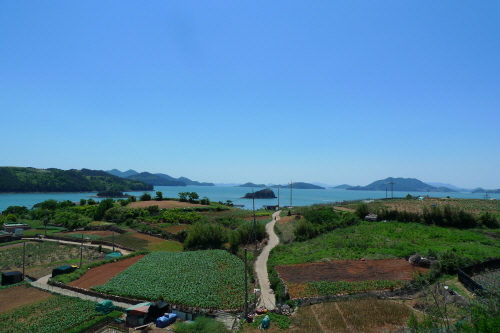
▲비탈 밭▲ 구릉마다 만들어진 밭을 보세요. 돌산갓김치가 자라고 있네요. 갓은 농약 없이 재배하는 대표적인 참살이 채소인 것, 아시죠? (Look at the fields on each hill. Leaf mustard is growing. It is a typical vegetable which is grown without pesticides.) ⓒ 김경훈
눈길을 돌려보면, 아 저기 사람 사는 마을과 사람 살리는 작물들이 자라고 있네요. 가던 발걸음을 멈춰 보세요. 그곳이 바로 돌산갓김치가 자라고 있는 땅이거든요.
(Look around! Oh! There is a village, field grows and growing crops for the people. Please slow your pace. That Dolsan Leaf mustard.)돌산은 해양성 기후와 알칼리성 토양 덕분에 갓이 자라기 좋은 풍토라고 하지요. 하지만 어디 그것뿐이겠어요. 비탈진 구릉에서 돌을 고르고 흙을 갈아엎어 밭을 만든 돌산 사람들의 땀이 없이, 돌산갓을 어찌 우리가 맛볼 수 있겠어요. 알싸하게 은근히 쏘는 맛이 일품인 돌산갓김치에는 '고된 노동이 만들어 낸 아름다운 절경'이 숨어 있어요.
(Dolsan has a good climate for growing leaf mustard because of its oceanic climate and alkaline soil. But that's not enough. Without sweat of Dolsan's people, who made a field by picking stones and changing the soil, how could we taste Dolsan leaf mustard? There is no hiding the hard work that goes into making the piquant Dolsan leaf mustard kimchi.) "돌산에는 아름다운 사람들이 살고 있어요."(There are living the beautiful people on Dolsan.)
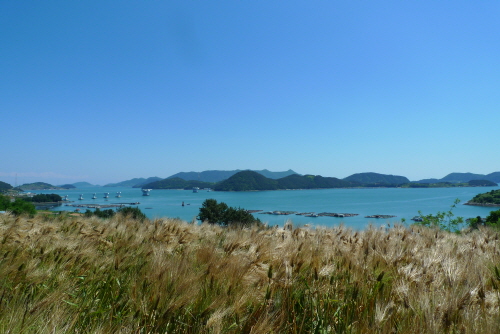
▲보리밭 푸른 바다와 은갈색 보리의 어우러짐 참 멋지죠? 이렇게 멋진 풍경을 어디서 볼 수 있을까요? (Harmony of the blue sea and barley. Cool, huh? Where do you see this beautiful scenery?) ⓒ 김경훈
이곳이 어디일까요? 태평양의 어느 섬? 아니면 지중해 연안의 이름난 휴양지? 아니에요. 이곳은 여수의 돌산에서 해안도로를 따라가다 보면 늘 만나볼 수 있는 풍경이에요. 엑스포가 열리는 기간인 오뉴월이 바로 보리가 필 때니까, 엑스포에 오시면 이 멋진 광경도 볼 수 있을 거예요.
(Where is it? Is it one of the Pacific island? Or a famous resort on the Mediterranean coast? No. You can always see scenery like this the coastal road at Dolsan of Yeosu. Expo will be held in May and June, which is when barley grows, You will be able to see this great spectacle when you come to Expo.)보리 하면 맥주가 생각날지 모르지만, 우리나라에서는 이 보리로 엿기름을 만들어 식혜를 만들어 먹어요. 달짝지근하면서도 시원한 맛이 여느 음료와 비길 수가 없죠. 이제는 캔으로도 만들어져 있으니 자판기에서 뽑아 드셔 보세요.
(You might think of beer when you think of barley. But in korea, we drink Sikhye, created by malt made with barley. Its sweet and cool flavor can't compare with any other drinks. They can be bought in cans at local stores. Or you can get it from a vending machine.)"돌산에는 우리 역사가 그대로 숨 쉬고 있어요."("Dolsan still breathes our national history.")
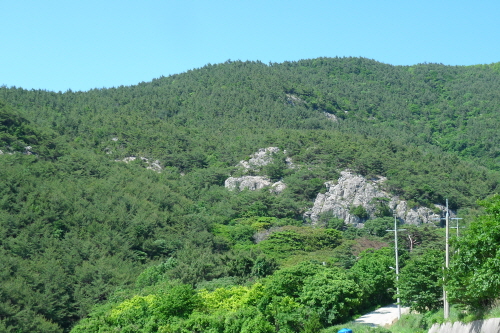
▲숨어 있는 절 동백나무와 후박나무숲에 가려 ‘숨어 있는 절’이 보이지 않아요. 하지만 보이지 않아도 보여요, 마음을 열면. (The temples are covered with camellias and silver magnolia, hiding the temple completely.) ⓒ 김희곤
평사 해넘이 길을 지나면 돌산읍 소재지인 군내리가 나와요. 이곳엔 이순신 장군이 거북선을 만들었던 방답진 선소 굴강이 있고, 옛날 공자의 제사를 지내고 고을 선비들이 공부를 하던 향교가 있지요. 그리고 고을 관아로 쓰였던 동헌과 관청이 원형대로 보존되어 있어요.
(After passing Pyeongsa on the sunset road, there is Gunnaeri, which belongs to Dolsan. There is Bangdabjin Seonso Gulgang, where General Yi made the Turtle Ship, and Hyanggyo, where classical scholars studied and commemorated Confucius. Dongheon and the government office have been preserved in their original forms.)돌산향교를 지나면 100년 역사를 자랑하는 돌산초등학교가 있는데 초등학교에서 50미터쯤 지나면 왼편으로 은적암 가는 작은 길이 있어요. 돌산에는 이렇듯 오랜 역사의 숨결을 느낄 수 있지요.
(After passing Dolsan Hyanggyo there is Dolsan elementary school, which was built a century ago. Fifty meters on, you can see the narrow road leading to Eunjeokam on your left. In Dolsan, you can feel its long history.)"은적암 가는 길은 천 년 전 그 길 그대로예요."("The road to Eunjeokam is the same that existed 1000 years ago.")
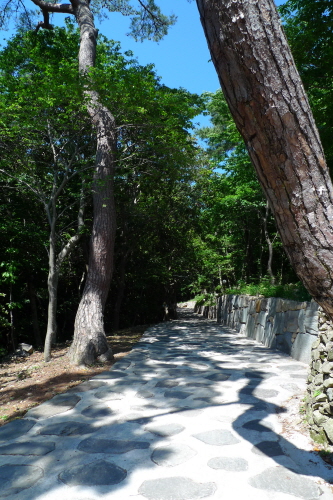
▲은적암 가는 길 은적암으로 가는 길목에서 만난 소나무는, 이 절의 역사를 말해 주고 있었어요. (The pine trees that are seen on the way to Eunjeokam tell the history of the temple.) ⓒ 김희곤
은적암은 고려 명종 25년(1195)에 보조국사가 세운 암자예요. 천 년의 세월을 견딘 오래된 절집이지요. 오솔길을 따라 한 걸음 한 걸음 걷노라면 마음이 가라앉지요. 이 길을 거닐면서 얼마나 많은 스님들이 '길'을 찾았을까요?
(Eunjeokam is the temple founded by Jinul in the Goryeo Dynasty, King Myeongjong 25 year(1195). Walking along the path will calm your mind.)길을 따라 올라가면 작은 도랑에서 졸졸졸 흐르는 물소리가 들리고, 이름 모를 새소리가 들리고, 천년 된 고목들을 스쳐 지나오는 바람소리가 들리지요. 그러다 보면 서늘하고 그윽한 기운에 몸과 마음의 때가 씻겨나가는 것을 느낄 수 있어요.
(Climbing a small ditch along the road we hear the sound of water flowing. A birds whose name you do not know is singing. There is a wind in the trees, which are thousands of years old. Then it's time for your body and mind to be purified by the cool wind.)"한국의 사찰은 다 은적암 같아요."("All Korean temples look like Eunjeokam.")

▲은적암 은적암은 자그마한 암자이지요. 하지만 은적암을 보면 한국의 사찰을 다 보았다고 해도 지나친 말이 아니에요. (Eunjeokam is a small hermitage. But looking at Eunjeokam is the same as looking all the temples in Korea.) ⓒ 김희곤
은적암은 아름답고 고즈넉한 암자이지요. 바위가 병풍을 두른 듯 둘러쳐져 있으며, 주변에는 소나무가 많아 여름에는 시원하고, 계곡을 따라 흐르는 물소리가 귀에 들릴 정도이거든요.
(Eunjeokam is a beautiful and quiet temple. It is surrounded by rocks, and it is cool in summer because of the shade of the pine trees. You can hear the sound of water flowing along the valley.)하지만 은적암의 아름다움은 다른 데 있어요. 불교는 수천 년 동안 우리의 정신 문화에 깊은 영향을 끼쳐 왔는데, 그것은 보이는 것이 전부가 아니라는 깨달음으로 이어지지요. 숨을 은(隱)에 고요할 적(寂)이라는 은적암의 이름에는 불교 정신이 그대로 녹아 있거든요. 한국의 사찰은 다 은적암 같아요, 크기만 다를 뿐.
(But the beauty of Eunjeokam is another thing. Buddhism has deeply affected our spirit and culture for thousands years. It teaches us that a visible thing is not all things. The name of the temple contains the Buddhist spirit. All Korean temples are like Eunjeokam. Only their sizes are different.)"향일암 가기 전에 성두 마을이 있어요."("There is Sungdu village before Hyangilam.")
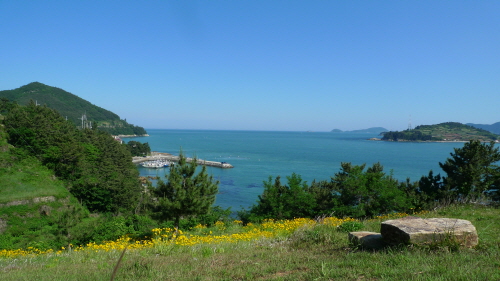
▲성두마을 바다의 멋진 수평선이 잘 보이는 성두마을이에요. 마을 옆에 있는 기암절벽이 웅장해요. (There is Seongdu village, with its fine view of the horizon. The cliff beside the village is magnificent.) ⓒ 김희곤
이제 돌산도 거의 다 왔네요. 버스 종점이자 돌산도의 남쪽 끝 마을인 성두 마을에 다다른 걸 보니 말예요. 길가로 노란 배추꽃이 초록빛 들판과 어우러져 푸른 바다를 더욱 아름답게 만드는 마을이지요. 그 길을 따라가다 보면 길 끝에 바위가 나오고, 그 바위에 잠시 앉아 바다를 바라보면 정말 가슴이 뻥 뚫리는 곳이지요.
(We have now arrived at the southern part of Dolsan, meaning we have seen the entire island. While following the road you can see the rocks at the end of the road. Sitting on the rocks and watching the sea, you can feel free.)하지만 배가 출출하네요. 그럼 성두 마을에 있는 전복 식당에서 전복죽 한 그릇 들고 가세요. 전복죽은 전복 창자에서 나오는 푸른 빛깔에 붉은 색 당근이 섞여서 보기에도 먹음직스러워요. 밥알에 섞인 전복이 씹히는 맛은 별미예요.
(Do you feel hungry? Then how about eating some abalone soup with rice? It will give you lots of stamina. It is made with abalones and vegetables. So it tastes fantastic and is so colorful.)"향일암의 부처님은 여전히 미소 짓고 계셨어요."("Buddha in the Hyangilam still smiles")

▲관음보살 향일암 관음보살님이 여전히 웃고 계시네요. 글라라 수녀님의 미소와 닮지 않았어요? (Hyangilam Kwaneum bodhisattva is still smiling. I think it resembles sister Geulrara's smile. Doesn't it?) ⓒ 지현우
돌산 여행의 마지막은 향일암에서 장식하는 게 딱이죠. 향일암은 아름다운 일출로 유명한 곳이지요. 하지만 가파른 절벽에 위치한 향일암 자체가 신비로움마저 느끼게 해요. 얼마 전 화재로 향일암의 일부가 사라졌는데, 부처님의 온화한 미소는 사라지지 않고 있어요.
(For a last stop in Dolsan, Hyangilam is the perfect place. Hyangilam is famous for its beautiful sunrise. It feels mysterious because of being located on a steep cliff. Not long ago, some of it disappeared, but Buddha's warm smile doesn't disappear.) 그런데 향일암 근처의 돌들은 신기하게도 거북의 등껍질 모양처럼 갈라져 있어요. 그래서 멀리서 보는 금오산의 모습은 마치 거대한 거북이가 넓은 바다로 헤엄쳐 가는 모습으로 보이죠. 금오산이 향일암을 안고 있다고들 하는데, 어찌 보면 향일암이 금오산을 받쳐 주고 있는 듯한 느낌도 들어요.
(The stones near Hyangilam are amazingly cracked, and shaped like a tortoise-back shell. In appearance, Mt. Geumo looks like a giant tortoise swimming into the wide sea. It is said that Mt. Geumo holds Hyangilam in its arms. In some way, it feels like it is holding Mt. Geumo.)"들어갈 때는 아침이었는데, 나올 때는 밤이네요."("We arrived in the morning, we now leave at night.")
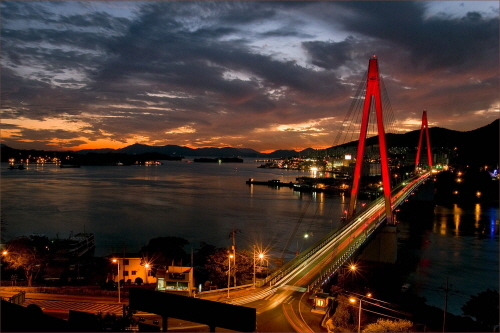
▲돌산대교 나오는 길 붉은 노을과 어우러진 돌산대교의 야경이에요. 왔던 곳으로 되돌아가는 게 삶이라는 걸, 말해 주는 것 같아요. (There is a wonderful night view of Dolsan Brigde. It tells us that life is consist of returning where we came.) ⓒ 정종현
벌써 해가 지고 있네요. 아쉽지만, 돌산 여행은 이 다리를 건너면 끝이 나요. ……들어올 때도 이 다리로 들어왔는데 나갈 때도 이 자리로 나가네요. 그래서 시작과 끝은 언제나 같은 자리라고 하는 걸까요?
(The sun is setting. I'm afraid I must say goodbye. Entering Dolsan, we crossed this Bridge. Leaving Dolsan, we cross it again. So, do we say beginnings and endings are always the same?)그러고 보니 여수엑스포 준비도 끝을 향해 가고 있네요. 하지만 그 끝에서 우리는 또 다른 시작을 꿈꾸고 있어요. 수많은 사람들이 여수를 찾아와서 새로운 지구촌의 21세기를 여는 그런 시작을 말이죠. 거기에서 바다는 살아나고, 연안은 다시 숨을 쉬는 기적이 시작될 거예요.
(Now EXPO preparation is almost done. But at the end of the preparation, we are dreaming help us of another beginning. I hope that many people all around the world will visit and open a new 21st century and a new unified world. The ocean comes alive, the seashore share starts to breathe with miracles again.)(기사 작성 : 동아리 <사랑해여수> 김희곤, 지현우, 김경훈 기자. 지도 교사 : 박용성) (News written by the group of 'ILOVEYEOSU', Kim Huigon, Ji Hyeonu , Kim Gyeonghun : Guidance teacher : Park Yongseong) 덧붙이는 글 | <사랑해여수>는 ‘2012년 여수세계박람회를 젊은이의 시각으로 세계에 알리기 위해서 조직된 동아리입니다. 그래서 영문으로 작성한 기사도 함께 쓰지요. 우리 동아리에는 여수(YEOSU)의 글자 하나씩을 따서 만든 ‘[Y]OUTH’, ‘[E]ARTH’, ‘[O]CEAN’, ‘[S]ECRET’, ‘[U]-CITY’ 총 다섯 팀이 있어요. 그리고 특별 취재팀으로 [X4]팀도 있습니다. 이 기사는 <사랑해여수> [U]팀에서 작성한 거예요.